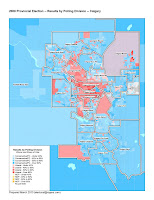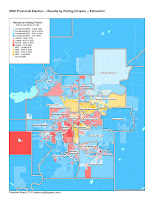(Re)Enter Mister Fjeldheim.
There has been a certain amount of attention focused on Alberta’s Chief Electoral Officer and his comments regarding his philosophy towards his newly re-inherited position. Brian Fjeldheim, who held the position from 1998 to 2005, was recently reappointed following the dismissal of his more activist successor-turned-predecessor Lorne Gibson. After re-assuming his role last week, Mr. Fjeldheim was a little more reserved when describing his role in advocating the importance of the vote to Albertans (60% of Albertans did not vote in the 2008 election). Dave Breakenridge offered some thoughts on Mr. Fjeldhiem’s comments in today’s Calgary Sun.
Open up the Elections Act.
In the next few weeks, Justice Minister Alison Redford is expected to introduce legislative amendments to Alberta’s aging Elections Act. Minister Redford has said that the amendments will include some of the 182 recommended changes submitted by Mr. Gibson before his departure (but will not include fixed election dates). Of course, the recommendations included in the Bill will have be carefully chosen and measured for political impact by Minister Redford and her PC cabinet colleagues. Minister Redford’s amendments will likely include changes to how Returning Officers are chosen. During the 2008 election, it was revealed that the PC Party had provided lists of candidates for Returning Officers to the Elections Office (over half of the appointed Returning Officers had partisan connections to the PC Party).
Elections procedures can be improved through legislation, but democratic participation can be strengthened through meaningful engagement. In September 2007, the Government of New Zealand tried something completely different. As an innovative way to capture the views of the public on what a new Policing Act should look like, the Ministry of Justice launched an online Wiki. This Wiki allowed citizens from across that country to contribute their ideas and collaborate in the creation of new legislation.
What better way to reinvigorate our Elections Act than by opening up the amendment process to allow Albertans to collaborate by contributing their ideas for changes and improvements? What better opportunity to do things differently in than by allowing Albertans to invest their own ideas into the development of the important piece of legislation that will decide how their elections are structured? Is there a more meaningful piece of legislation that could be opened up to public collaboration than the Elections Act? Would this kind of online collaboration succeed in Alberta? There is only one way to find out.
Prior to entering elected office in 2008, Minister Redford cultivated an international legal career helping build democracies in countries around the globe (including as one of four international election commissioners appointed by the Secretary General of the United Nations to administer Afghanistan’s first parliamentary elections in September 2005). Legislative amendments can improve structure, but opening up the Elections Act to real public collaboration could be Minister Redford’s big opportunity to create more meaningful democratic participation in Alberta.
Making it easier for students to vote.
I am sure that there would be no shortage of Albertans who would contribute their ideas to an open dialogue on improving our Elections Act. The Council of Alberta University Students submitted a handful of recommendations (pdf) to Minister Redford last year when they heard about the upcoming legislative amendments. Each of the five recommendations have been adopted by Elections officials in provinces across Canada (though no jurisdiction has adopted all five). The recommendations would improve access to a voting demographic that due to its geographic transience, are likely to face barriers and challenges to participating in elections.

These are good recommendation, most of which would require minor administrative changes that are not anything that a little Alberta ingenuity could not overcome. Decreasing barriers to voting for younger Albertans will create a positive culture of participating in elections and could help create life-long voters – a group that is increasingly becoming a minority in Alberta elections. I hope to see some of these positive improvements included among Minister Redford’s amendments.
Coming Soon: New Maps.
Alberta’s Electoral Boundaries Commission is due to release its interim report by February 26, 2010.






